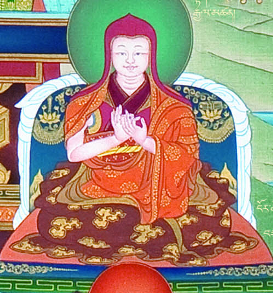Ngor Monastery: Difference between revisions
Jump to navigation
Jump to search
No edit summary |
No edit summary |
||
| Line 3: | Line 3: | ||
Ngor Monastery is divided into four monastic houses (Tib. ''[[labrang]]''; Wyl. ''bla brang''): | Ngor Monastery is divided into four monastic houses (Tib. ''[[labrang]]''; Wyl. ''bla brang''): | ||
*Luding, | *Luding (''klu sdings''), | ||
*Khangsar, | *Khangsar (''khang gsar''), | ||
*Thartse and | *Thartse (''thar rtse'') and | ||
*Phende | *Phende (''phan bde'') | ||
==Ngor Monastery in Exile== | ==Ngor Monastery in Exile== | ||
Revision as of 19:11, 9 November 2010

Ngor Monastery (Wyl. ngor evaṃ chos ldan) — an important Sakya monastery, and seat of the Ngor subschool, established by Ngorchen Kunga Zangpo around 1430. Before being completely demolished during the Chinese invasion, it was a very active monastery, counting about 1,000 monks in the 1950s. It has only been partly reconstructed.
Ngor Monastery is divided into four monastic houses (Tib. labrang; Wyl. bla brang):
- Luding (klu sdings),
- Khangsar (khang gsar),
- Thartse (thar rtse) and
- Phende (phan bde)
Ngor Monastery in Exile
- Ngor Monastery was reestablished in Manduwala, India
Further Reading
- Ronald Davidson, 'The Ngor-pa Tradition' in Wind Horse, vol. 1, 1981, pp.79-98
- David Jackson, 'Sources on the Chronology and Succession of the Abbots of Ngor E-waṃ-chos-ldan', Berliner Indologische Studien. Band 4/5: 49-93, 1989.
- David P. Jackson, 'The 'Bhutan Abbot' of Ngor: Stubborn Idealist with a Grudge against Shugs-ldan' in Lungta 14, 2001